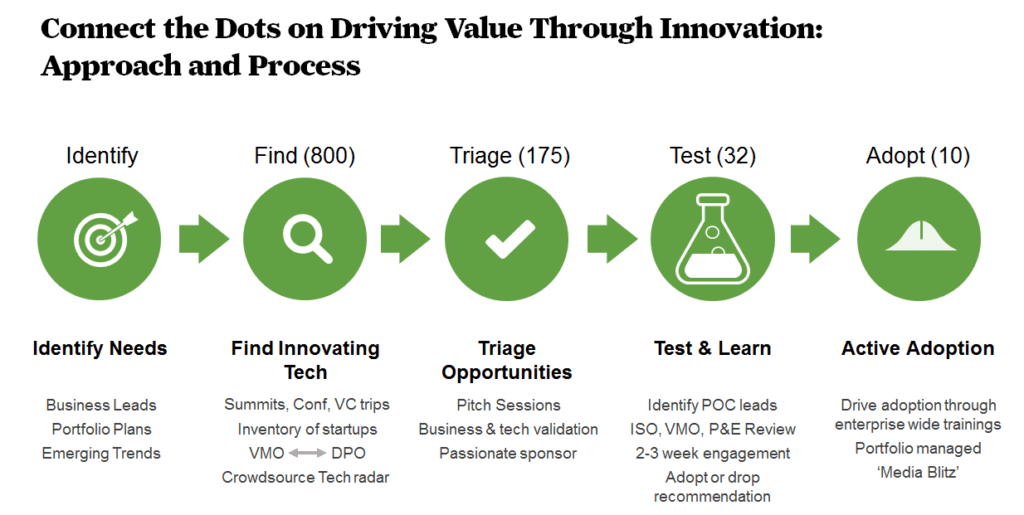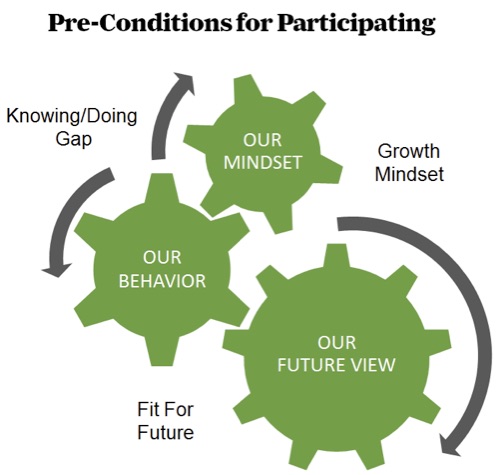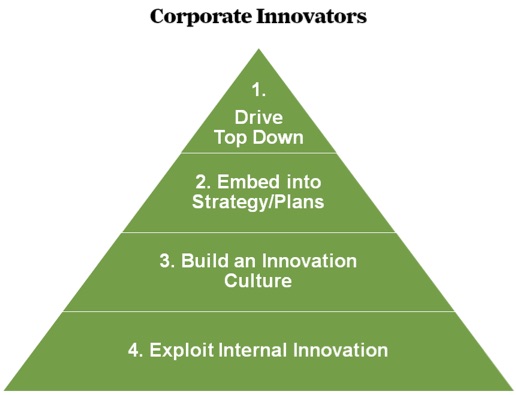
Corporate innovation is not a new topic, but today there is an increased sense of urgency at the executive leadership level. We are witnessing disruptive innovation in nearly every sector. Traditional markets from banking, transportation, and even healthcare all face new disruptive forces, and often from outside of their normal market of competitors. For corporate leaders, the ability to embrace innovation, both organic and inorganic, is therefore an objective goal. Sourcing best practices on corporate innovation and creating a culture that supports new ideas, risk taking, and even failure are key elements that CEOs, CIOs, and their teams are thoughtfully pursuing.
As part of our CIO speaker series, we asked Anju Gupta, head of digital partnerships at Monsanto, to tell us how the $13.5 billion agro-chemical giant drives innovation through its organization. Matthew Le Merle, the author of ‘Corporate Innovation in the Fifth Era,’ joined our speaker series to share the principles of innovation that make up some of the science that Monsanto is applying.
Here are the key takeaways:
- Hone your ‘Tech Radar’ by keeping your eyes out for emerging technologies; attending VC summits and bringing in startups for pitch sessions is a good way to stay ahead of the curve.
- Start with small investments, run fast pilots, and showcase that they work before you go for a big deployment strategy.
- When you allow business units to run their own tech proofs of concept, they are more vested in understanding how the technology can improve the business; these POC leads become champions for change.
- If you continually help your business partners understand how technology is changing the way they operate, you’ll establish a foundation of trust, making them more receptive to potentially transformative ideas later on.
- You can’t operate in a vacuum. Your CIO and CTO need to be fully engaged, and without support from the business leads you’ll never be able to drive tech innovation.
- Breaking down silos between business units and collaborating are the keys to success. Without that, innovation isn’t possible.
Anju Gupta on Innovation at Monsanto
At Monsanto, we’ve instilled a culture of innovation that permeates every aspect of the organization. And we’ve done it through a series of strategic partnerships with VCs and startups.
By pursuing these partnerships, we’ve been able to accelerate the capabilities of our platform, enable strategic transformation, and generate new growth opportunities.
Along the way, we’ve identified five essential steps to help drive innovation.

Identify business needs: We start by talking with business unit leaders across the organization – from manufacturing, marketing, supply chain, finance, R&D, and so on – to uncover their pain points.
Find innovative technology: We are continually looking for promising technologies to solve business problems. By attending VC summits and technology conferences, and working closely with our procurement and portfolio review groups, we identified 800 opportunities we wanted to explore over the last two and a half years.
Triage the opportunities: By running each opportunity through a rigorous business and technological validation process, we winnow the original list of startups down to a more manageable number that we solicit pitches from. We then further reduce that to a handful we can start to test.
Test & Learn: After identifying proof-of-concept leads within each business function, we create rapid, 2- to 3-week POC engagements that are reviewed by our procurement, standards, and engineering groups, ending with a recommendation to either adopt or drop. Once a technology is recommended, the business units are expected to fund it.
Actively Adopt: Of the original 800 startups, we have adopted 10 new technologies each year, which we deployed to our employees via enterprise-wide training sessions, as well as an internal ‘media blitz’ to promote rapid adoption.
For example, artificial intelligence is a key driver of innovation for Monsanto. But we quickly realized that if we wanted to play in the AI field we needed to democratize analytics, making it more accessible to more employees. So we partnered with an external company to bring machine learning as a service to the entire enterprise, and tested the platform using a team of data scientists.
In our tests, we found that a project that would normally that would take four data scientists 12 weeks to complete could be performed on this platform in four hours using one data scientist. So we adopted that platform pretty quickly.
Leadership development is also important. Every year our HR department brings in more than 50 high-potential leaders to run six-month pilots as part of their professional development. We give them a problem like how to implement deep machine learning into their business functions, and they have to come up with a solution. At first, they’re like the deer in the headlights. Six months later they come up with how the technology can improve the business, and become its biggest champions.
Ultimately, you need a very small number of individuals from your organization to be able to partner with VCs, and you also need a very large number of startups to be engaging with you. That’s what drives digital transformation.
Corporate Innovation in the Fifth Era
Monsanto began their process for innovation excellence by extensively researching the topic. One key input was a book written by Matthew Le Merle, founder of Fifth Era. Matthew joined our CIO Insight Call and shared his thoughts on the process for creating a culture of innovation and the ‘preconditions for participating’ that speak to the need of creating a mindset for growth and aligning the corporate strategy and team. The concept of innovation must be led from the top, and embedded into the business plans, and should have a process for internal and external innovation.
Matthew has focused on analyzing the behaviors and key themes of some of most innovative organizations, and has come up with several key points on how companies need to embrace innovation as a shared value.

Innovation strategy must be aligned with business strategy and supported by corporate culture
- Many don’t have an innovation strategy at all
- Most don’t have high alignment|
- The most innovative companies do, as do most Silicon Valley companies
- High alignment correlates to superior profitability/enterprise value growth
Many companies chose to include innovation as a corporate shared value
- But most employees don’t have a mandate to be innovative in a breakthrough way
- For most employees the shared value needs to be translated into continuous improvement around customer experience standards and pride in products and services offered
- This provides the basis of the cultural support required for alignment
Most executives agree that future innovations in their industry will not be driven by their company
- However most of their innovation spend is internally focused
- Some companies have begun to develop external innovation efforts, but the sources and spend are not close to being aligned
- As a result we expect massive reallocation of spending to focus on external innovation and a shift to corporate innovators catalyzing innovations rather than generating them

Corporate Innovation Self-Assessment: As a close to our discussion, we offered a self-assessment that every company can use to refine its own view of Corporate Innovation.
Drive Innovation Top-Down
1. Is your CEO also your chief innovation officer? Yes/No
2. Does innovation prominently feature on the CEO and board agendas? Yes/No
3. Do you see your executive leadership team living innovation in their actions and behaviors? Yes/No
4. Are your leaders passionate about encouraging the organization to be innovative? Yes/No
Embed Innovation into Strategies and Plans
5. Do you have a clearly defined innovation strategy? Yes/No
6. Is your business strategy fully aligned with you innovation strategy? Yes/No
7. Do your business unit leaders believe they own the innovation strategy too? Yes/No
Build an Innovation Culture
8. Does your corporate culture support your innovation strategy? Yes/No
9. Are you customer-driven in your innovation approach? Yes/No
10. Should all employees be able to innovate products and services offered? Yes/No
11. What percent of your employees have a mandate to innovate products and services? X= ____%
12. What does innovation as a shared value mean to the rest of your people?
Exploit External Innovation
13. Do you have a well-developed external innovation strategy? Yes/No
14. Over the next decade where will the most important innovations in your industry come from?
a. Your company? b. Your industry? c. Outside your industry?
15. What percent of your innovation spend is internal vs. external — people and capital? ____%
16. What percentage of your innovation spend focuses beyond your industry? ____%
Self-Scoring: Add up the number of yes answers you five in questions 1,2,3,4,5,6,7,8,9,and 13.
10 out of 10 — Your corporate innovation approach is like that of the most innovative companies.
7 to 9 inclusive — You can implement additional best practices of the most innovative companies.
Less than 6 — You have an urgent need to transform your corporate innovation approach.

